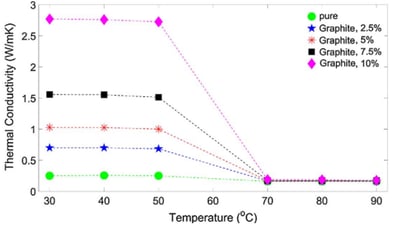Across the globe, the transportation industry has begun shifting towards electric vehicles. From dedicated companies like Tesla, to older automotive companies like Volkswagen, the entire industry is embracing the EV trend. This is primarily due to climate change and the gradual shift away from fossil fuels like gasoline. However, one of the biggest hurdles to overcome in EV proliferation is that of thermal management.
 Figure 1: Lithium car battery, showing the individual cells packed in one unit.
Figure 1: Lithium car battery, showing the individual cells packed in one unit.
Heat buildup has been a concern across the electronics industry; temperature alone accounts for about 42% of all electronic faults [1]. However, the scale required for electric vehicles makes battery thermal management more difficult, and more dangerous if not done properly. Many solutions have been proposed and are being tested. Thermal conductivity is a key parameter needed for this research in order to accurately model the heat transfer.
What is Thermal Conductivity?
 Figure 2: A diagram showing one dimensional heat conduction through a plane wall
Figure 2: A diagram showing one dimensional heat conduction through a plane wall
Thermal conductivity is a property that describes a material’s ability to transfer heat. A material with a high thermal conductivity, such as most metals, will become hot much faster than something with low thermal conductivity, like insulation. Thermal conductivity is measured in W/mK (Watts per meter Kelvin): a heat source (W), travels through a distance (m) in the direction from high to low temperature (K).
Thermal conductivity is a key performance indicator in the thermal management of electric vehicles. Materials with a high thermal conductivity can act to quickly transfer generated heat out and away from the battery pack. Meanwhile, materials with a low thermal conductivity can serve as thermal barrier materials, helping to prevent any fires from spreading to the rest of the vehicle. Many methods exist for battery thermal management; one increasingly common method being implemented is that of phase change materials (PCMs).
Phase Change Materials
PCMs are often used within the battery, as an interstitial material between the cells. They will absorb the heat being generated, and eventually that heat will be used to change the material form a solid to a liquid, thus preventing temperature increase. Since the PCM is in direct contact with the battery, a high thermal conductivity is desired to increase the rate of heat transfer.
A study from the University of Windsor examined the impact of adding graphene nanoparticles into a wax PCM, the results of which can be seen below.
 Figure 3: Graph showing the increase of thermal conductivity in the solid face with increasing nanoparticle concentration [2]
Figure 3: Graph showing the increase of thermal conductivity in the solid face with increasing nanoparticle concentration [2]
This particular material changed phase at 60°C, meaning that prior to that it was in the solid phase, and afterward the liquid. These results show that adding the nanoparticles had a significant increase on the thermal conductivity in the solid phase but had no impact on the liquid phase. This was accomplished by the addition of graphite nanoparticles which, despite their small size, can greatly increase the thermal conductivity of the entire material.
Measuring the Thermal Conductivity of PCMs
Characterizing PCMs can be difficult. Most methods are unable to characterize liquid materials, and many have high temperature demands which pose problems for flammable materials such as wax. One method, the Modified Transient Plane Source (MTPS) can circumvent both of these problems.
 Figure 4: C-Therm's Modified Transient Plane Source (MTPS) thermal conductivity sensor.
Figure 4: C-Therm's Modified Transient Plane Source (MTPS) thermal conductivity sensor.
The MTPS method uses a very small heat pulse to accurately measure the thermal conductivity of samples. A known current is applied to the sensor, generating a heat pulse into the PCM.A guard ring surrounds the sensor, which ensures one dimensional heat transfer from the sensor into the sample. The change in voltage at the interface is recorded, and the thermal conductivity is found based on calibrations in the software.
 Figure 5: MTPS sensor equipped with the liquid cell for measuring the thermal conductivity of liquids or powders.
Figure 5: MTPS sensor equipped with the liquid cell for measuring the thermal conductivity of liquids or powders.
The MTPS is also able to measure the PCM in its liquid state. This is accomplished by the use of a liquid cell. This small metal apparatus has an O-ring to contain the liquid, and the test is performed the same way as for solid materials. The heat pulse that is generated is fast, as low as 0.8 seconds, which stops natural convection from being a source of error.
Battery thermal management systems are an increasingly important area of research as the automotive industry trends toward electric vehicles. The use of phase change materials is one of many methods used to help remove heat from the battery cell. The thermal conductivity of materials such as these is a necessary parameter to accurately understand how the heat will travel, and thus the safety of the system as a whole.
For more resources:
- C-Therm and RheoSense joint webinar: https://www.rheosense.com/webinar-thermal-and-rheological-analysis-ev-battery
- Detailed paper on the thermal management of EVs: https://ctherm.com/resources/tech-library/thermal-management-in-electric-vehicles/
- Webinar on preventing thermal runaway with PCMs: https://ctherm.com/resources/webinars/preventing-thermal-runaway/
References:
[1] Li, X. et al. (2017). A review of typical thermal fatigue failure models for solder joints of electronic components. IOP Conference Series: Materials Science and Engineering. https://iopscience.iop.org/article/10.1088/1757-899X/242/1/012103/pdf
[2] Bahiraei, F, Fartaj, A, & Nazri, G. (2017). Experimental and numerical investigation on the performance of carbon-based nanoenhanced phase change materials for thermal management applications. University of Windsor. https://www.sciencedirect.com/science/article/pii/S0196890417308890?casa_token=J6JGibZa6xcAAAAA:Gfhhv9LUvInXioImilSXkpdRVuGwSYzwFEgfEuM2P9VeBxiMWMCYntF-gwqFtGeUAeCyfg4MGJY
Written by: John Clifford, C-Them Technologies Ltd Technical Specialist

